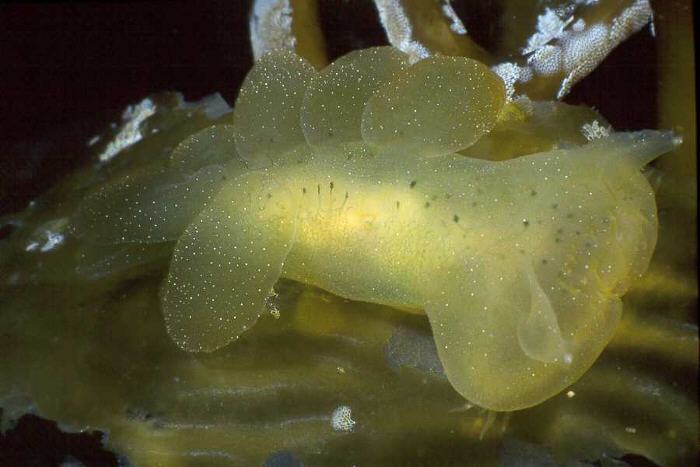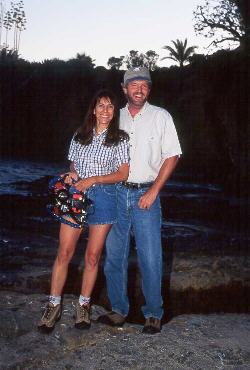 |
Melibe leonina
Courtesy of Bruce WightSan Miguel Island, California
Melibe leonina (Gould, 1852)
The genus Melibe belongs to the Nudibranch suborder Dendronotacea, making it
related to the Tritonia's, Doto's and Dendronotus's. Melibe leonina has
been dubed the Lion Nudibranch, for obvious reasons. The specific name
'leonina' was chosen because of the African Lion's mane appearance of the
oral hood. This modified structure makes Melibe leonina one of the most
characteristic members of the Opisthobranchia, and one worth stopping to
watch the next time you are in a kelp bed.
This species uses this large muscular oral hood to feed similarly to an island fisherman with a Hawai'ian throw net. The animal expands and inflates the hood and reaches forward throwing or casting it at it's prey. Years ago I saw a series of photos from British Columbia showing some 6 to 8 specimens siting side-by-side on a rock all with their hoods open like a line of outfielders ready to catch a fly ball. It almost suggested that by lining up with nets at the ready, they were optimizing some sort of planned feeding strategy.
The wide flattened cerata of this species are easily autotomized (they fall off) when disturbed by fish or predators, as a defensive mechanism, inviting the predator to follow the detached body part drifting in the current, rather than stay around and hassle the animal itself.
In central California, populations follow a unique bi-modal curve peaking in numbers twice annually, in spring and fall. Throughout its range specimens are most common in kelp beds and on the giant kelp, Macrocystis. A great way to finish a dive in kelp is to slowly ascend while greeting the sun rays filtering through the kelp and look for the egg mass of M. leonina on the fronds of the kelp. In the northern parts of the range specimens can measure as large as 90 mm in length, meaning their oral veils can open to the size of a silver dollar. Melibe leonina's range is documented from Bahia de Los Angeles within the Gulf of California north to Kodiak Island, Alaska.
Truly the opisthobranch version of the "King of Beasts" this species feeds on just about any thing that is unfortunate enough to swim in front of its gaping head. Many of you have shared accounts finding this carnivore feeding on all sorts of crustacea, small jellyfish and ctenophores and even small fish.
You aint seen nothing until you have pointed your camera down this Lion's
throat. To quote another cat, "It's GRRRRRREAAAAATTTT!!!"
Sept. 1999
Bruce and Johanna Wight at Shaw's Cove

Jo is a great top side photographer and recently picked up U/W photography. In their first year and a half together they made over 100 dives. They are both branchers with a passion for natural history and Southern California diving. Jo is a Biologist working in the biotechnology industry and Bruce is an Engineer at Boeing. Bruce has had underwater photographs published in The Orange County Register, Discover Diving and Personal Watercraft Illustrated. They are both members of the SDUPS and live in Laguna Niguel, CA. Send Bruce and Johanna email at bwproductions@earthlink.net |
Taxonomic information courtesy of Dave Behrens

David W. Behrens
Author:
Pacific Coast Nudibranchs |
